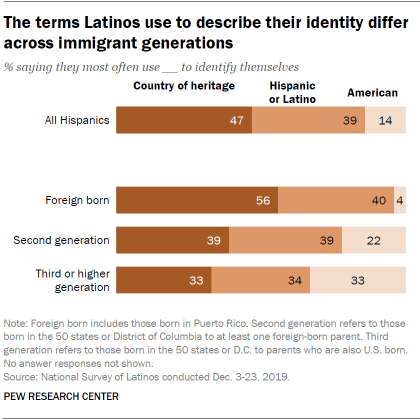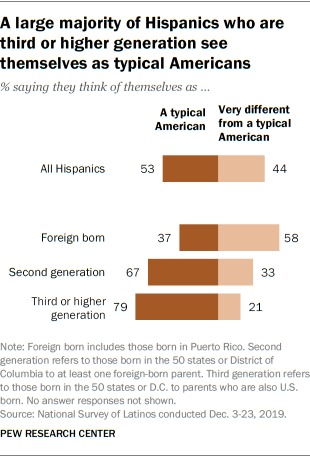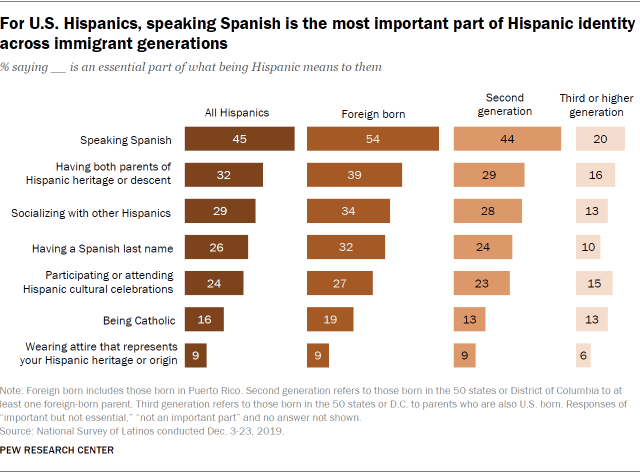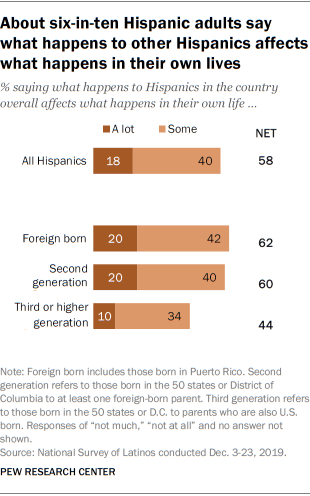The terms Hispanics in the United States use to describe themselves can provide a direct look at how they view their identity and how the strength of immigrant ties influences the ways they see themselves. About half of Hispanic adults say they most often describe themselves by their family’s country of origin or heritage, using terms such as Mexican, Cuban, Puerto Rican or Salvadoran, while another 39% most often describe themselves as “Hispanic” or “Latino,” the pan-ethnic terms used most often to describe this group in the U.S.
Meanwhile, 14% say they most often call themselves American, according to a national Pew Research Center survey of Hispanic adults conducted in December 2019.
The use of these terms varies across immigrant generations and reflects their diverse experiences. More than half (56%) of foreign-born Latinos most often use the name of their origin country to describe themselves, a share that falls to 39% among the U.S.-born adult children of immigrant parents (i.e., the second generation) and 33% among third- or higher-generation Latinos.
For this analysis of what Hispanics think is important to their identity, we surveyed 3,030 U.S. Hispanic adults in December 2019 as part of Pew Research Center’s 2019 National Survey of Latinos. The sample includes 2,094 Hispanic adults who were members of the Center’s American Trends Panel (ATP), an online survey panel that is recruited through national, random sampling of residential addresses. It also includes an oversample of 936 respondents from Ipsos’ KnowledgePanel, another online survey panel also recruited through national, random sampling of residential addresses.
Recruiting panelists by phone or mail ensures that nearly all U.S. adults have a chance of selection. This gives us confidence that any sample can represent the whole population (see our Methods 101 explainer on random sampling), or in this case the whole U.S. Hispanic population.
To further ensure that this survey reflects a balanced cross-section of the nation’s Hispanic adults, the data is weighted to match the U.S. Hispanic adult population by gender, nativity, Hispanic origin group, education and other categories. Read more about the ATP’s methodology.
For the purposes of this report, references to foreign-born Hispanics include those born in Puerto Rico. Individuals born in Puerto Rico are U.S. citizens by birth. The survey was conducted in both English and Spanish.
Here are the questions used for this report, along with responses, and its methodology.
Meanwhile, the share who say they most often use the term “American” to describe themselves rises from 4% among immigrant Latinos to 22% among the second generation and 33% among third- or higher-generation Latinos. (Only 3% of Hispanic adults use the recent gender-neutral pan-ethnic term Latinx to describe themselves. In general, the more traditional terms Hispanic or Latino are preferred to Latinx to refer to the ethnic group.)
The U.S. Hispanic population reached 60.6 million in 2019. About one-third (36%) of Hispanics are immigrants, according to a Pew Research Center analysis of U.S. Census Bureau data. Another third of Hispanics are second generation (34%) – they are U.S. born with at least one immigrant parent. The remaining 30% of Hispanics belong to the third or higher generations, that is, they are U.S. born to U.S.-born parents.
The December 2019 survey also finds U.S. Hispanics are divided on how much of a common identity they share with other Americans, though views vary widely by immigrant generation. About half (53%) consider themselves to be a typical American, while 44% say they are very different from a typical American. By contrast, only 37% of immigrant Hispanics consider themselves a typical American. This share rises to 67% among second-generation Hispanics and to 79% among third-or-higher-generation Hispanics – views that partially reflect their birth in the U.S. and their experiences as lifelong residents of this country.
Speaking Spanish seen as a key part of Hispanic identity
What it means to be Hispanic can vary across the group. Hispanics most often say speaking Spanish is an essential part of what being Hispanic means to them, with 45% saying so. Other top elements considered to be part of Hispanic identity include having both parents of Hispanic ancestry (32%) and socializing with other Hispanics (29%). Meanwhile, about a quarter say having a Spanish last name (26%) or participating in or attending Hispanic cultural celebrations (24%) are an essential part of Hispanic identity. Lower shares say being Catholic (16%) is an essential part of Hispanic identity. (A declining share of U.S. Hispanic adults say they are Catholic.) Just 9% say wearing attire that represents their Hispanic origin is essential to Hispanic identity.
The importance of most of these elements to Hispanic identity decreases across generations. For example, 54% of foreign-born Hispanics say speaking Spanish is an essential part of what being Hispanic means to them, compared with 44% of second-generation Hispanics and 20% of third- or higher-generation Hispanics.
Most Latinos feel at least somewhat connected to a broader Hispanic community in the U.S.
For U.S. Latinos, the question of identity is complex due to the group’s diverse cultural traditions and countries of origin. Asked to choose between two statements, Latinos say their group has many different cultures rather than one common culture by more than three-to-one (77% vs. 21%). There are virtually no differences on this question by immigrant generation among Latinos.
Few Hispanics report a strong sense of connectedness with other Hispanics, with only 18% saying what happens to other Hispanics in the U.S. impacts them a lot and another 40% saying it impacts them some. Immigrant Hispanics (62%) are as likely as those in the second generation (60%) to express a sense of linked fate with other Hispanics. This share decreases to 44% among the third or higher generation.
Note: Here are the questions used for this report, along with responses, and its methodology.




